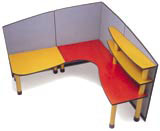Sense and sustainability
Sara Manuelli looks at how design can play an active role in influencing a change in a business’ ethos when it comes to social and environmental concerns

Sustainable design has become a fashionable catchphrase in these caring, organic, GM-fearing years. But beyond the media hype, there has been a valid shift in trend as businesses, entrepreneurs and designers are slowly adopting measures that take the wider environmental and social picture into account.
From the Design Museum’s Design Sense Awards, which honours products and buildings in terms of their impact upon the environment, to the recent, Richard Seymour-instigated British Design & Art Direction SuperHumanism debate, designers are accepting responsibility to improve people’s lives without drying up the world’s resources.
And although the recent refusal of the US President George Bush’s administration to comply with the Kyoto agreement is an ugly reminder that we are a far cry away from affecting the mismanagement of globalisation, there is still a validity in resistance by defining a ground-level approach.
‘Sustainability is a design issue,’ says Clive Grinyer, director of design and innovation at the Design Council and a Design Sense Awards judge. ‘The factors that have raised sustainability up the agenda in other countries are not just emotional. There are strong economic as well as environmental reasons to develop methods of sustainable consumption. Legislation is the most powerful driver of behavioural change and because many countries in the European Union have anticipated more advanced legislation, our competitors are well ahead.
‘Although our business leaders appear not to have noticed or yet feel it to be a pressure in the market, consumer demand for sustainable behaviour will increase. Sustainable behaviour has to be designed into companies’ systems, from how they communicate internally and externally, to how the raw materials are chosen and used and how consumption of resources is understood throughout an organisation. To achieve such a fundamental change, a sustainable world will have to look, feel and behave differently. A radically different design response is required,’ Grinyer says.
But what makes a design sustainable? According to Edwin Datschefski, author of The Total Beauty of Sustainable Products, published by Rotovision, ‘Sustainable design results in products and processes which are good for people, profits and the planet. You can’t have a great product if it just looks nice on the outside. It has to be made in a way that does not harm workers or pollute the environment. And, of course, it has to sell. The days of dodgy Green products are gone now. The best products are sustainable and successful.’
However, profit-oriented companies haven’t jumped on the responsible bandwagon until forced to. On Nike’s website, you will find corporate responsibility programme clips, as well as virtual tours in some of Nike’s publicly condemned contract factories in Vietnam. Last year’s Landor Associates-designed BP flower identity, a hotly debated attempt at revising the petroleum giant’s poor political and environmental image, has hardly been strengthened by its second quarter record production figures.
These are the big guys, the ‘evil corporations’ that stand under fire from the no-logo squadrons. Subject to public scrutiny (and shareholder concern), they have been obliged to change tack or at least face improving their communication skills with tools such as environmental reports. What is interesting, is how designers can bring these concerns back to the drawing board, way before production is set in motion, and how smaller projects can impinge on manufacturing and consuming habits.
To convince business that sustainability is a feasible proposition, the Design Council set up a project in May to track ten companies for a year to monitor their progress towards more sustainable business. The companies that are taking part range from the large, BA and Jaguar, to SMEs. ‘Their experience will help others identify exactly what practical steps can be taken to reduce the environmental and economic costs of energy and material consumption,’ says Grinyer.
Education is also increasingly promoting sustainable design on its agenda, with initiatives such as Kingston University’s Designing for Sustainability Research group and the Helen Hamlyn Research Centre’s Design for our Future Selves Awards. Suddenly, designing for a better planet makes perfect sense. m
Design Sense 2001: Sustainable Design Awards is at the Design Museum, 28 Shad Thames, London SE1, from 31 August until 4 November.
For information on sustainability go to www.demi.org.UK or www.fourthdoor.co.UK
-
Post a comment



